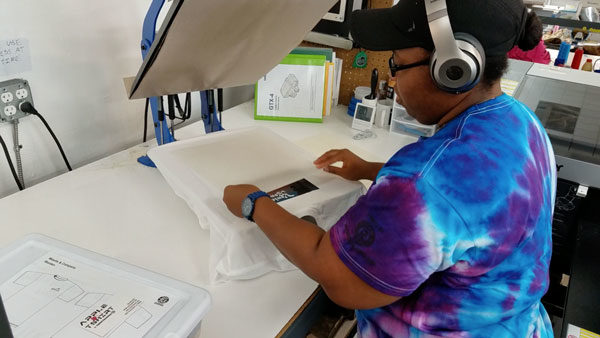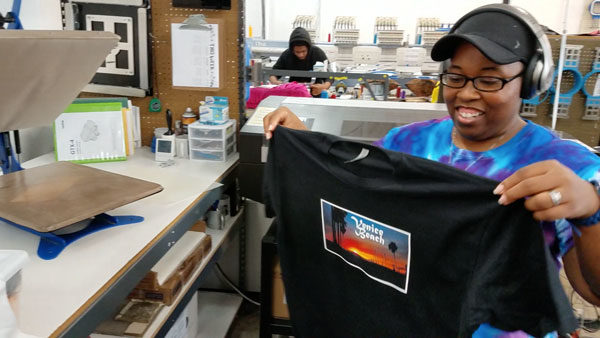T-Shirt Design and Production: Direct To Garment Printing
It’s time to talk t-shirts again! My name is Sebastian bleak and for over 7 years, I was a Production Manager for the best custom t-shirt shop in Los Angeles. And I’m excited to share what I learned there in a series of articles here at CreativePro, called T-Shirt Design and Production. In this article, we’re talking Direct To Garment aka “DTG” printing for t-shirts.
What is DTG?
I remember tripping out when I first saw a DTG Printer because it basically looked like a Frankenstein’d desktop printer, that you could stuff t-shirts into instead of paper. I guess it just looked crazy to me seeing a t-shirt go into a printer and come out already printed with a really cool graphic on it, in just a couple of seconds. I was immediately impressed to say the least!

When this print method was introduced, they literally used large Epson printers, modified with a track and a platen system to load the shirt for printing. Special inks have to be used in order for this to work on a t-shirt but the printer head and print process is basically the same. All you have to do is export your artwork as a PNG, load your shirt and hit print! Well, that’s the short version, there’s actually a little more to it than that.
The Process
There’s generally two different ways to work with a DTG printer. One is using CMYK only and the second is by adding a white underbase for colored shirts. When you print without a base, you are only printing CMYK and it’s printing directly onto the t-shirt. The underbase will feel slightly raised on the shirt because of its layers of ink and pretreatment, but this allows you to print white ink and see your graphics on dark shirts.
I wouldn’t be able to tell you which one is better because it would be a personal preference and it depends on the project. Most people don’t touch the graphics on their shirts, so they might never notice the extra layer of ink. If the “feel” of the shirt is important to you, I’d look at some options where can avoid a base, but then you will be limited to working with lighter colors.
CMYK Only, No Base
If you’re going to be printing on a light-colored shirt and white ink is not needed for your graphic, then you will be able to print CMYK without a base. When an underbase is not needed, you can skip the pretreatment steps and load your T-shirt into the DTG printer.

Next you want to bring up your artwork in the RIP software, set up the proper print placement.

And then hit the Print command. Once the print is complete, the shirt is removed from the platen and placed on a heat press to cure the ink.

And we’re done! When looking at the print on the white shirt, do you notice the white text “Venice Beach”?

That is an absence of ink and you are able to see the shirt color show through. If you skip the underbase and print only in CMYK, you get a really soft print of your graphic on the garment. It almost feels as though it’s part of the shirt itself.
Black Shirt with Underbase
Pretreatment of the garment is necessary when you are Printing an underbase for your T-shirt. Before the printing process, a chemical is sprayed onto the T-shirt and heat pressed till dry. This will allow the white ink to sit on top of the fabric which makes your graphic visible on the shirt. This is done for all prints that require and underbase.

What designs need an underbase? Anytime you need white ink to print or if you’re printing on dark-colored shirts. So if the color white appears in your design and you want to print it on a black or green shirt, you will need an underbase. If you’re printing on a white shirt, then no base is needed. Think of the shirt as paper. You can get away with printing on a light colored shirt, without a base, but anything that should be white will take on the color of the shirt. So make sure to keep that in mind.
After the shirt has been pretreated, the rest of the process is the same as CMYK only. Your design and underbase will print simultaneously by a print head that slides back and forth, the same way your desktop printer would. Just make sure to cure the ink and we’re done!

Voila! Your new favorite shirt ready to wear to every occasion. When the base is needed, you will be able to feel the ink and pretreatment more but it’s not a dramatic change. It still ends up being a lot softer than screen printing in my experience.
Key Tip: Talk to Your Printer Early On
Talk to the people that will be printing your shirt before you start designing. You want to have this talk during the idea phase so you can bounce around ideas on whether to use a base or go CMYK only. You can also talk print size limitations, print locations available or if DTG is even the best print method for you.
What to Expect
Since we’re using an inkjet printhead, you will be able to produce higher-quality prints than before. Your graphic won’t look exactly as it does on the monitor, because it’s on a textured surface, but it’s really close. The main difference is your image will soften slightly and you’ll be able to see some of the shirt texture show through. It’s also a good idea to avoid large areas of solid ink. The fibers tend to move around which then create a moiré pattern that kind of looks like sawdust on the print. You can try using gradients to avoid creating large solid areas.
When to Use DTG
The DTG method is great option if you’re printing low quantities of t-shirts with many colors in the design. It also does a really good job generating gradients without halftones. If you’re not sure what would qualify as a “low quantity,” I would recommend using this print method for a run of 1-36 shirts. After that, it’s best to consult with your printer to see if this is still the best print method for you. Where DTG really shines is that there’s no setup fee, there’s usually quicker turnarounds and no minimums for most print shops. Keep in mind Direct to Garment printing needs natural fibers for the ink to adhere to. That means if you are using a polyester garment, the ink will wash away in the laundry. Your best bet would be to go with a 100% ring spun cotton t-shirt. You’ll get a solid print and the shirt feels nice and soft.
Next time you have a really cool graphic you want to show off on a t-shirt, give Direct to Garment printing a shot. I’d love to see what you all come up with, so please feel free to tag me on Twitter @sebastianbleak so I could check out your next favorite t-shirt!



Please I want to print samples of schools badges on white cotton clothes. I believed you can advice better on what to do. I’m ready to send you a sample before we talk on cost.
i am looking for veterans that own a dtg printer that would to partner with my American Pride Casual wear. do to shipping cost of t-shirts we need to set up veterans to cover local areas for american legion, vfw, eagle, moose organizations… my proceeds go to sponsor Americas Wounded Heroes on a Music jam cruise. utube & facebook friends2veteransAmerica